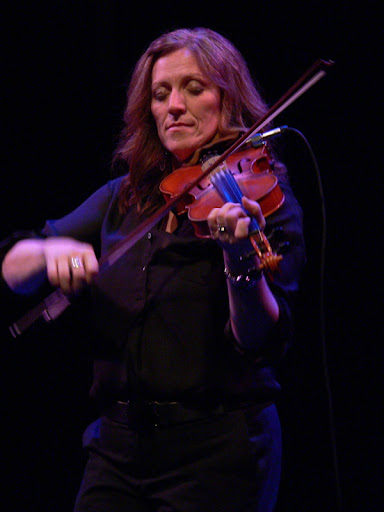“There’s a saying in Gaelic that culture is passed on knee to knee, between generations,” says musician Mary Jane Lamond. “My grandparents were Gaelic speakers, so I was always interested in the language. I think I was first drawn to the literary tradition, which is a very oral tradition here on Cape Breton. Gaelic language, spending time with Gaelic speakers became a big part of my social life, and so did spending time with people who were interested in songs, both older songs and newer ones,” she says. “I think I really found my voice when I started singing in Gaelic.”
Wendy MacIsaac’s grandparents were Gaelic speakers also, “so although I don’t always understand every word Mary Jane sings, I understand, you know?” she says. “My first bit of music was step dancing,” she recalls. “My mom taught step dancing lessons -- with Natalie MacMaster’s mom, actually -- in communities on Cape Breton and I'd go out with them and just pick it up from being in the circle at those lessons." When MacIsaac began to learn the fiddle, the rhythms and feeling of the music and language of Cape Breton were already in her. “I almost immediately started playing for dances, and when you play three hours a night several nights a week for dancers, you learn about tempos and you learn a lot of tunes!” She also plays those tunes at times on piano and mandolin.

Lamond and MacIsaac have been friends for almost two decades and have often worked on projects and appeared in concert together. Seinn, though, is the first time they’ve made a recording which focuses on their music as you might hear it of an evening’s concert that features the two. “We were both overdue to put out an album,” says MacIsaac, “so we decided it was time.”
On Seinn, they offer thoughtful and graceful interweaving of tune and song, music that comes from deep in the traditions of Cape Breton and of Scotland and contemporary music which draws on these traditions and landscapes. The album opens with Yellow Coat, a set of fiddle tunes old and new which invite you to imagine the steps of dancers, and to join in the dancing yourself. Lamond follows with Air a Ghille Tha Mo Run/It is the Lad That I Love, a gentle love song. As the music unfolds on the recording, there are songs and tunes of work, of travel, of change, of love -- music which connects with and shares the landscape and life of in this far northern part of Atlantic Canada, including the song Taladh na Beinne Guirme/The Blue Mountain’s Lullaby, a story of changes in Gaelic culture in the Blue Mountain area of Cape Breton. Whether you are familiar with Scottish Gaelic or not, the stories come though clearly in Lamond’s singing, as they do in the tunes on MacIsaac’s fiddle as well.
MacIsaac and Lamond invited several friends along on the project. “It took us about a year to do it, and at times we just stopped working on it because we were both busy with other commitments," says MacIsaac. “But I think those chances to take a bit of breath now and then helped us bring it all together. We hadn’t started out with the idea of guests musicians either, but those breaks helped us bring them in, too.” Among those who sit in are regular band mates Seph Peters on guitar and Cathy Porter on percussion and accordion, and from Scotland David Milligan on piano and Corrina Hewat on harp, from Ireland T with the Maggies, and from Cape Breton Ashley MacIsaac on piano and Patrick Gillis on guitar.
Both MacIsaac and Lamond believe in passing on their love and understanding of Cape Breton culture as it was given to them as well, both at home in Atlantic Canada and on the road as they travel. “One of my favorite things when we go to festivals is doing workshops and showcases,” MacIsaac says. “I was at a workshop where the other musicians were a woman from the national orchestra of China and a guy who played cajun fiddle, and then I got up and played strathspeys and reels. It was as much fun for us on stage as it was for the people in audience!” At the time of this conversation, Lamond was working with interpreters at the Highland Village Folk Museum in Cape Breton, helping them learn about how to share aspects of Gaelic culture. “It’s a museum that looks at history of the emigrants from Gaelic Scotland to Nova Scotia," she says, “and there’s a folk school here in the summer which brings together elders and peers in that intergenerational learning model --knee to knee!”
Read more: Celtic Colours: A Tapestry of Celtic Culture
Kerry Dexter is Music Editor for Wandering Educators. You may reach Kerry at music at wanderingeducators dot com
You may find more of Kerry’s work at Music Road, Journey to Scotland, Perceptive Travel, Strings, National Geographic Traveler, and other places in print and on line.
Feature photo: Corrina Hewat in background w/ harp and Mary Jane Lamond in foreground w/mic
Photographs are courtesy of and copyright Kerry Dexter. They were made at the Celtic Connections Festival with permission of the artists, the festival, and the venue.
This article was originally published in 2013 and updated in 2018
